Reptiles are some of the best known, charismatic and feared of all animals, they have a very long and significant history as a group, including the dinosaurs, pterosaurs and icthyosaurs. The reptiles evolved from Amphibians that became increasingly terrestrial and no longer dependent on living in or around water. Descendants of the dinosaurs also live on today as the mammals and birds.
Reptilia - Reptiles
Being cold blooded, reptiles are confined either to warmer environments or the warmer times of year in more temperate regions where they will hibernate in the colder months. They are often observed basking on warm rocks and in the sun in order to raise their body temperature to a level where they can become more active. Not having to generate their own body heat means that they do not need as much food as a similarly sized warm blooded animal.
Typical Reptiles
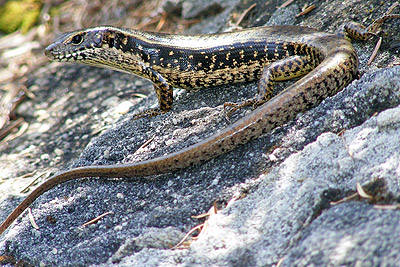
A typical small lizard
Picture Adam.J.W.C.
GFDL via Wikimedia Commons
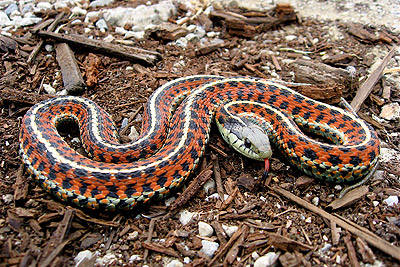
Coast Garter Snake -
Thamnophis elegans terrestris
picture Steve Jurvetson
from Menlo Park, USA CC-BY-2.0, via Wikimedia Commons
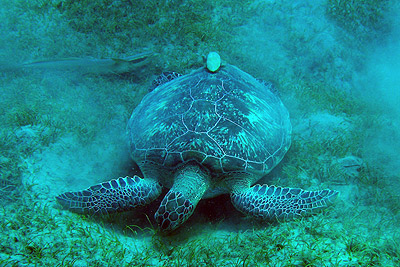
A Green Sea Turtle -
Chelonia mydas
This one
is feeding on sea grass, they eat the leaves and also
the nutritious rhizomes, roots that run horizontally
beneath the sand surface. First of all the turtle wafts
away the sand with its large fore-flippers to enable
it to reach the roots more easily. The fish on its back
is a remora, a harmless passenger that tags along for
the ride.
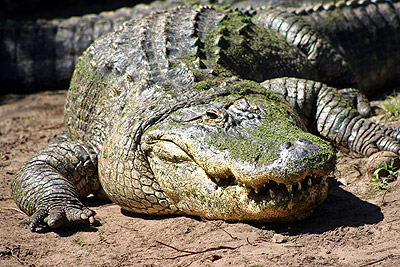
American alligator -
Alligator mississippiensis
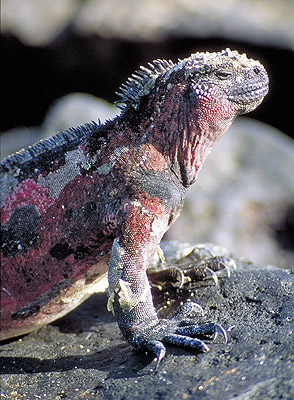
Marine iguana -
Amblyrhynchus cristatus
The
only marine lizard species lives on the Galapagos Islands
where it is herbivorous and dives in the sea for food.
Cool Reptiles
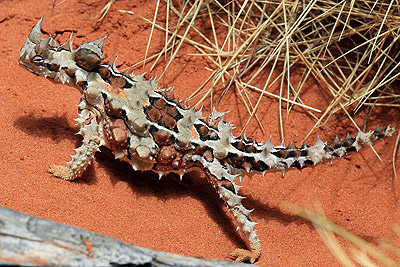
Thorny Devil -
Moloch horridus
from Western
Australia looks fierce and scary, but is only a maximum
of 20cm (8 inches) long and feeds on ants. There are
tiny grooves between the scales which can channel water
to the mouth so allowing this lizard to obtain water
from fog or even damp sand or soil.
picture Jarrod CC-BY-2.0 via
Wikimedia Commons
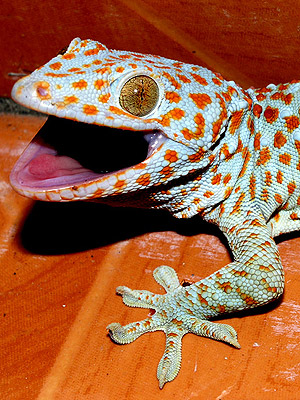
A Tokay Gecko -
Gekko gecko
A native of India
through much of South East Asia. It's natural habitat
is trees and cliffs though it adapts to human habitations
where it hunts insects climbing across walls and ceilings
to reach them.
picture
Nick Hobgood CC-BY-2.0 via Wikimedia Commons
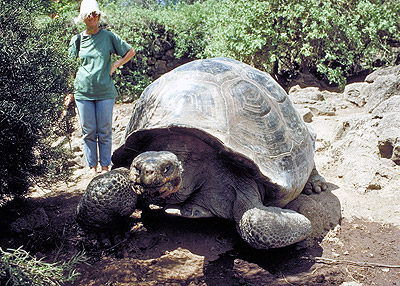
Giant Galapagos tortoise - Saddleback
- Geochelone nigra
These tortoises can grow to 250kg (550lbs). There
are currently 11 different subspecies living on the
Galapagos Islands, it is possible to identify the island
that some of the subspecies come from by the shape of
their carapace (shell). Historically there were 12 and
possibly up to 15 subspecies. They were able to grow
so large and to such variety as they have always been
the only large herbivores on the Galapagos Islands so
having no competition from others.
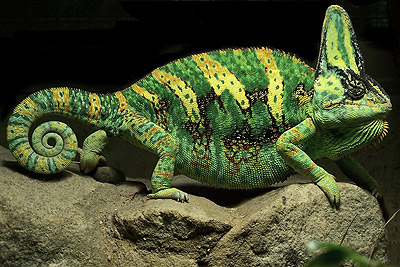
Veiled Chameleon / Yemen Chameleon
- Chamaeleo calyptratus.
This individual is quite vivid at the
moment, the particular shade can change from this bright
lime green through to a drab olive with red tinges to
the patches.
Picture used
by permission Kupos
CC-BY-SA-3.0 via Wikimedia Commons
Videos
Thorny Devil
Iguanas chased by snamkes - BBC,
Planet Earth II
Kingdom - Animalia
Phylum - Chordata
Subphylum - Vertebrata
Class
- Reptilia
Basic Features:
Reptilia is a Class in the Subphylum
Vertebrata of
the Phylum Chordata, so they have all of the characteristics
of both of these groups in addition to the following:
What do reptiles eat?
Reptiles are mainly or partially carnivorous though there are some herbivorous species.
Snakes are completely carnivorous, they may use poison to subdue their prey, biting and then following it rather than tackling it directly. They may kill by constricting (it is suffocation that kills the prey rather than crushing directly) or simply swallow their prey whole. Egg eating snakes swallow bird eggs whole before sawing into them with tooth-like projections along the backbone and then spitting out the shell as they break.
Snakes eat all manner of smaller animals of any kind they can catch, some species even specializing in eating other snakes.
Insectivores - Many small reptiles feed on insects, geckos often live around human habitations where the lights attract insects after dark. When I lived in the tropics a number took up residence behind the pictures hanging on the walls when they would wait for mosquitoes to land nearby then run out and eat them before disappearing back behind the picture again.
Chameleons have a remarkable means of catching insects with a tongue that is as large as between one and one and a half body lengths that is ballistically launched at over 26 body lengths per second, they can use them to capture insects in flight. videos here
Ambush predators - Some reptiles, particularly snakes and crocodiles lie in wait for their prey waiting for them to come close before striking. Large crocodiles may attack very large prey such as antelope, buffalo, zebras and humans, anything they can subdue and kill by submerging and killing underwater. Typically a crocodile will float just at the surface with only its eyes showing, looking like a floating log, an unwary land animal will venture too close when the croc will strike launching itself forwards with explosive force using its back legs and hugely powerful tail, the eyes are retracted into the head at this point for protection. The prey is then dragged into the water held in place with the most powerful jaws in the animal kingdom. A crocodile may eat so much when it does feed that it can go without another decent meal for about a year.
Herbivores - being a vegetarian is not common amongst reptiles as a whole, though is common amongst the iguanas and tortoises. The only marine lizard, the marine iguana found only in the Galapagos Islands is herbivorous feeding on marine algae that it rasps from underwater rocks at depths of up to 10m (30 feet). Land dwelling iguanas are also largely herbivorous, though many will opportunistically eat invertebrates and also carrion. During the dry season, they will eat parts of plants that contain the most water such as the flowers deriving all of their water from this source at times.
Many tortoise species are strict vegetarians though
others are opportunistic feeders on worms and even carrion.
Typically they have a very varied diet that changes
with the seasons and food availability.
Green
sea turtles are herbivorous as adults feeding on sea
grasses and algae.
Leatherback turtles - feed primarily on jellyfish, they have lots of long backwards pointing spines in the upper region of their digestive tract to pass the slippery prey down to the stomach. They can sometimes get into trouble by ingesting plastic bags that when floating in the water can look like jellyfish.
What eats reptiles?
Small and medium sized reptiles are fair game for a whole range of other specialist and opportunist predators including other reptiles along with birds and mammals. The smaller ones can be killed and eaten by large spiders.
The group includes:
The status of the reptiles and their sub-groups
changes as more is discovered and understood about their
evolutionary relationships. I have named some of the
major groups without saying which level the group is
(class, order, etc.) as doubtless the hierarchy will
change whereas the names are relatively constant. The
following list is representative but not complete.
Testudines - turtles, terrapins and tortoises
- Cheloniidae - sea turtles, 7 species that occur worldwide in tropical oceans. Large animals that may exceed 2m (6 feet 6 inches) in length and 680kg (1500 lbs) for a large leatherback. Hawksbill, green sea turtle, loggerhead
- Chelydridae - snapping turtles, 3 species from N and S America and SE Asia. Very large heads and powerful jaws - alligator snapping turtle.
- Testudinadae - tortoises, land dwelling members of the group with shorter stouter legs that can often be fully retracted into the shell. Legendarily slow moving and long-lived with many verified at 150+ years and some at possibly 200+ years. Aldabra and the Galapagos have their own endemic giant tortoise species (several subspecies in the Galapagos) that grow up a meter or more long. Most other tortoise species are much smaller up to about 30cm (12 inches) long.
Rhynchocephalia - tuataras
Resembling lizards but actually two surviving species
of a group that was common 200 million years ago. Large
animals up to 80cm (31 inches) long with a spiny crest
along the back. Found in New Zealand only where they
are rare and threatened species.
Squamata - Scaled reptiles
Sauria (Laterta) - lizards
- Amphisbaenians - "worm lizards", elongated bodies with most species having no limbs.
- Gekkota - gekkos. A varied group of around 800 species that range from 1.6cm (0.6 of an inch) to 60 cm (2 feet) in length, often brightly coloured. Many species have adhesive toe pads that allow them to walk on walls and even cling to glass. Common in tropical and sub tropical countries where they are attracted to areas around lights at night that draw insects in. Tails can be shed to evade predators and regrown later. Tokay gecko, House gecko, Leopard gecko
- Iguania
- Chamaeleonidae - chameleons. A very distinct and specialized group, independently moving eyes on protruding cones, the ability to change colour quickly, characteristic grasping feet and a very long tongue that can be fired at prey.
- Iguanidae Frequently large tropical new-world lizards. Some are tree dwelling, some live amongst rocks and one species is marine, diving up 10m to feed on sea weed and algae. Marine iguana, Black iguana, Common green iguana, Anoles.
- Agamaidae - agamaids. Very similar in appearance to iguanids, though are found in the old-world. May be very brightly coloured with some limited ability to change colour. Bearded dragon, Thorny devil, Flyingdragon,
- Varanidae - monitor lizards. Often
large mainly carnivorous lizards, includes the largest
living lizard, the Komodo dragon at 3m (10 feet) and
up to 55kg (120lb). Water monitor, Nile monitor, Desert
monitor
Serpentes - snakes.
Elongate carnivores lacking in limbs, eyelids and external ears, food is swallowed whole. Over 2,700 species that range from 10cm (4 inches) up to 9m (30 feet) long, some have poisonous venom though are in the minority, others are sensitive to infrared light so helping them hunt in the dark. Pythons, Boas, Vipers, Cobras, Rattlesnakes, Sea snakes.
Crocodylia
Crocodiles. Large aquatic ambush hunters that can grow to over 4.85m (15.9 feet) long and weigh over 1,200 kg (2,600 lb), the smallest species however are around 1m in length, usually found in freshwater, though sometimes in brackish or marine habitats. The fourth upper tooth is visible when the mouth is shut. They may be farmed for meat or their skins. Nile crocodile, Saltwater crocodile.
Alligatoridae
- Alligatorinae - alligators. Two current species, one from the south of the USA and the other from the Yangtze river in China. Shorter wider heads that crocodiles and less dangerous to humans.
- Caimaninae - caimans. Central and South American reptiles similar to alligators though more agile with longer and sharper teeth.
Gavialidae
Top banner picture - Bluntheaded tree snake, used permission of Geoff Gallice from Gainesville FL USA under CC2 attribution Generic license.
